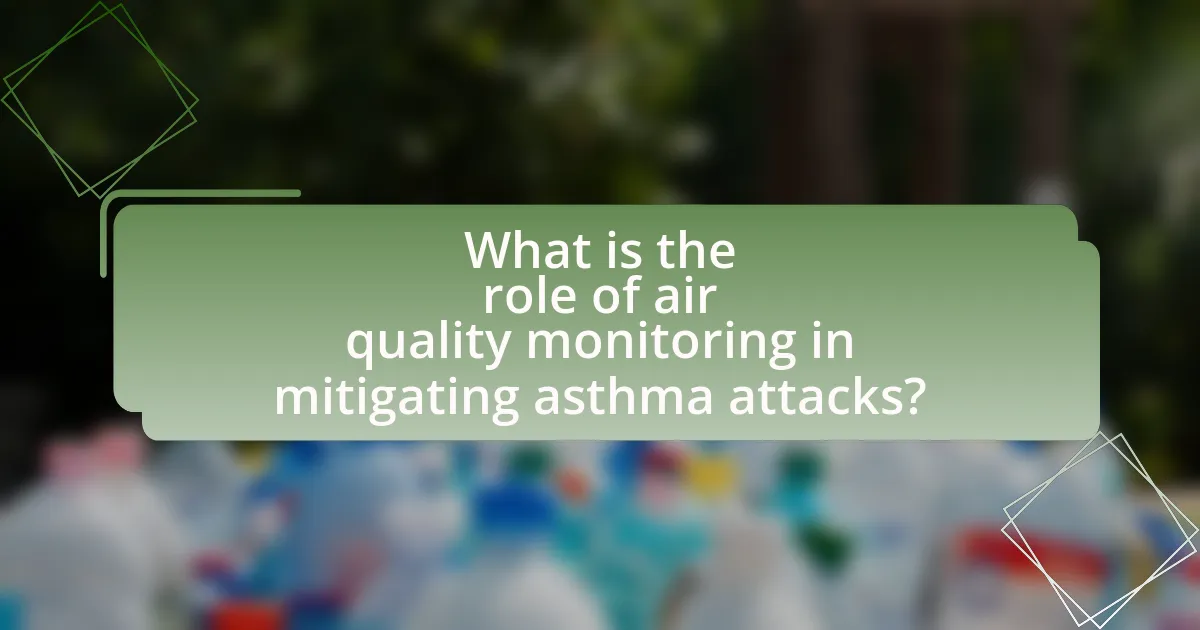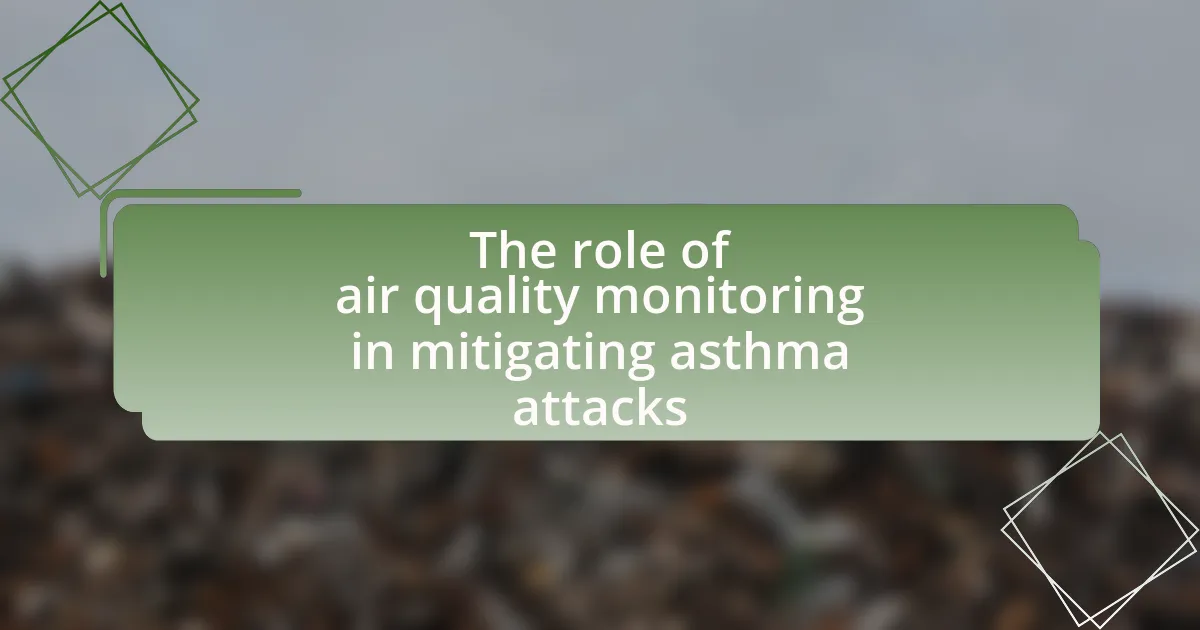Air quality monitoring is essential in mitigating asthma attacks by providing real-time data on pollutants that can trigger respiratory issues. This article explores the impact of air quality monitoring on asthma management, highlighting specific pollutants such as particulate matter and ozone that exacerbate symptoms. It discusses the correlation between air quality indices and asthma attack frequency, the technologies used in monitoring, and the role of mobile applications in enhancing patient awareness. Additionally, the article addresses the challenges of implementing effective monitoring systems and offers best practices for asthma patients to utilize air quality data in reducing triggers.
What is the role of air quality monitoring in mitigating asthma attacks?

Air quality monitoring plays a crucial role in mitigating asthma attacks by providing real-time data on pollutants that can trigger respiratory issues. By tracking levels of allergens, particulate matter, and other harmful substances, individuals with asthma can make informed decisions about their outdoor activities, especially during high pollution days. Studies indicate that exposure to elevated levels of air pollutants, such as ozone and particulate matter, is linked to increased asthma symptoms and hospitalizations. For instance, research published in the journal “Environmental Health Perspectives” found that short-term exposure to high levels of particulate matter significantly correlates with asthma exacerbations. Therefore, effective air quality monitoring systems enable timely alerts and public health interventions, ultimately reducing the frequency and severity of asthma attacks.
How does air quality monitoring impact asthma management?
Air quality monitoring significantly impacts asthma management by providing real-time data on pollutants that can trigger asthma symptoms. This data enables individuals and healthcare providers to make informed decisions regarding exposure levels, allowing for timely interventions such as adjusting medication or avoiding outdoor activities during high pollution days. Studies have shown that areas with effective air quality monitoring systems report fewer asthma-related hospitalizations, as patients can proactively manage their condition based on accurate air quality information. For instance, research published in the Journal of Asthma indicates that patients who utilize air quality alerts experience a reduction in asthma exacerbations by up to 30%.
What specific pollutants are monitored for asthma prevention?
Specific pollutants monitored for asthma prevention include particulate matter (PM2.5 and PM10), ozone (O3), nitrogen dioxide (NO2), sulfur dioxide (SO2), and carbon monoxide (CO). These pollutants are known to exacerbate asthma symptoms and trigger attacks. Research indicates that exposure to high levels of these pollutants correlates with increased asthma hospitalizations and emergency room visits, highlighting the importance of monitoring air quality to protect individuals with asthma.
How do air quality indices relate to asthma attack frequency?
Air quality indices are directly correlated with asthma attack frequency, as higher pollution levels often lead to increased respiratory issues. Studies have shown that elevated levels of particulate matter (PM2.5), ozone, and nitrogen dioxide, which are reflected in air quality indices, can trigger asthma symptoms and exacerbate existing conditions. For instance, research published in the journal “Environmental Health Perspectives” indicates that a 10 µg/m³ increase in PM2.5 is associated with a 6% increase in asthma-related emergency room visits. This evidence underscores the importance of monitoring air quality to predict and potentially mitigate asthma attacks.
Why is air quality monitoring essential for asthma patients?
Air quality monitoring is essential for asthma patients because it helps identify harmful pollutants that can trigger asthma symptoms and attacks. By tracking levels of allergens, particulate matter, and other irritants in the air, patients can take proactive measures to avoid exposure during high-risk periods. Studies show that poor air quality is linked to increased asthma exacerbations; for instance, research published in the Journal of Allergy and Clinical Immunology indicates that elevated levels of ozone and particulate matter significantly correlate with hospital admissions for asthma. Therefore, consistent air quality monitoring empowers asthma patients to manage their condition effectively and reduce the likelihood of severe attacks.
What are the health implications of poor air quality for asthma sufferers?
Poor air quality significantly exacerbates asthma symptoms and increases the frequency of asthma attacks. Exposure to pollutants such as particulate matter, ozone, and nitrogen dioxide can lead to airway inflammation, increased bronchial hyperreactivity, and reduced lung function in asthma sufferers. Studies indicate that individuals with asthma are particularly sensitive to these pollutants, which can trigger acute respiratory distress and necessitate emergency medical interventions. For instance, research published in the journal “Environmental Health Perspectives” found that elevated levels of air pollution correlate with increased hospital admissions for asthma-related complications, highlighting the direct health risks associated with poor air quality for this vulnerable population.
How can real-time air quality data influence patient behavior?
Real-time air quality data can significantly influence patient behavior by providing immediate information on pollution levels, which can prompt individuals, especially those with respiratory conditions like asthma, to take preventive actions. For instance, when patients receive alerts about high levels of particulate matter or ozone, they may choose to stay indoors, reduce physical activity, or use their inhalers proactively. Studies have shown that access to real-time air quality information correlates with reduced emergency room visits for asthma attacks, as patients are more likely to adhere to their management plans when they are informed about environmental triggers. This proactive behavior can lead to better health outcomes and a decrease in the frequency of asthma exacerbations.
What technologies are used in air quality monitoring?
Air quality monitoring utilizes various technologies, including sensors, remote sensing, and data analytics. Sensors, such as electrochemical and optical devices, measure specific pollutants like particulate matter, nitrogen dioxide, and ozone in real-time. Remote sensing technologies, including satellite imagery and LIDAR, provide large-scale atmospheric data, allowing for the assessment of air quality over extensive areas. Data analytics, often powered by machine learning algorithms, process and interpret the collected data to identify trends and predict air quality changes. These technologies collectively enhance the understanding of air pollution and its impact on health, particularly in relation to asthma attacks.
What types of sensors are commonly employed in air quality monitoring?
Commonly employed sensors in air quality monitoring include electrochemical sensors, optical sensors, and metal oxide semiconductor sensors. Electrochemical sensors are widely used for detecting gases such as carbon monoxide, nitrogen dioxide, and ozone due to their sensitivity and low cost. Optical sensors, which utilize light scattering or absorption techniques, are effective for measuring particulate matter concentrations. Metal oxide semiconductor sensors are known for their ability to detect a variety of gases and are often used in portable air quality monitoring devices. These sensors play a crucial role in providing real-time data that can help mitigate asthma attacks by informing individuals about air quality conditions.
How do mobile applications enhance air quality monitoring for asthma patients?
Mobile applications enhance air quality monitoring for asthma patients by providing real-time data on air quality levels, enabling timely alerts and personalized recommendations. These applications utilize data from environmental sensors and government sources to inform users about pollutants such as particulate matter and ozone, which can trigger asthma symptoms. For instance, studies show that apps can reduce asthma-related hospital visits by up to 30% by allowing patients to avoid high-risk areas during poor air quality conditions. Additionally, features like symptom tracking and medication reminders further empower patients to manage their condition effectively.
How can air quality monitoring be integrated into asthma action plans?
Air quality monitoring can be integrated into asthma action plans by incorporating real-time air quality data to inform individuals about environmental conditions that may trigger asthma symptoms. This integration allows patients to adjust their activities based on air quality levels, such as staying indoors during high pollution days or when pollen counts are elevated. Studies have shown that individuals with asthma who utilize air quality information can reduce their exposure to triggers, leading to fewer asthma attacks and improved overall health outcomes. For instance, the American Lung Association emphasizes the importance of using air quality indices to guide daily decisions for asthma management.
What are the challenges in implementing effective air quality monitoring?
The challenges in implementing effective air quality monitoring include high costs, technological limitations, and data interpretation difficulties. High costs can hinder the deployment of comprehensive monitoring networks, as establishing and maintaining air quality stations requires significant financial investment. Technological limitations arise from the need for accurate and reliable sensors, which may not be widely available or affordable. Additionally, data interpretation difficulties stem from the complexity of air quality data, which requires expertise to analyze and translate into actionable insights. These challenges can impede the effectiveness of air quality monitoring systems, ultimately affecting their role in mitigating asthma attacks.
What best practices can asthma patients follow regarding air quality monitoring?
Asthma patients should regularly monitor air quality to manage their condition effectively. They can utilize air quality apps and websites that provide real-time data on pollutants, allergens, and weather conditions. For instance, the Air Quality Index (AQI) offers a standardized way to assess air quality, helping patients identify days when outdoor activities may trigger asthma symptoms. Additionally, patients should keep track of local pollen counts, as high levels can exacerbate asthma. Research indicates that exposure to high levels of particulate matter can lead to increased asthma attacks, emphasizing the importance of monitoring air quality. By staying informed, asthma patients can make proactive decisions about their activities and reduce the risk of exacerbations.
How can individuals utilize air quality data to reduce asthma triggers?
Individuals can utilize air quality data to reduce asthma triggers by monitoring pollution levels and adjusting their activities accordingly. For instance, when air quality indices indicate high levels of pollutants such as ozone or particulate matter, individuals can limit outdoor activities, especially strenuous exercise, to minimize exposure. Studies show that poor air quality is linked to increased asthma symptoms; for example, the American Lung Association reports that elevated ozone levels can exacerbate respiratory issues. By staying informed through local air quality reports or apps, individuals can make proactive decisions, such as staying indoors on days with poor air quality, thereby reducing the likelihood of asthma attacks.
What resources are available for staying informed about air quality levels?
To stay informed about air quality levels, individuals can utilize resources such as the Air Quality Index (AQI) provided by the Environmental Protection Agency (EPA), which offers real-time data on air quality across the United States. Additionally, mobile applications like AirNow and Plume Labs provide localized air quality information and forecasts. Websites such as Breezometer and World Air Quality Index also aggregate data from various monitoring stations globally, allowing users to track air quality trends. These resources are validated by their use of government and scientific data, ensuring accurate and timely information for public awareness and health safety.

Leave a Reply